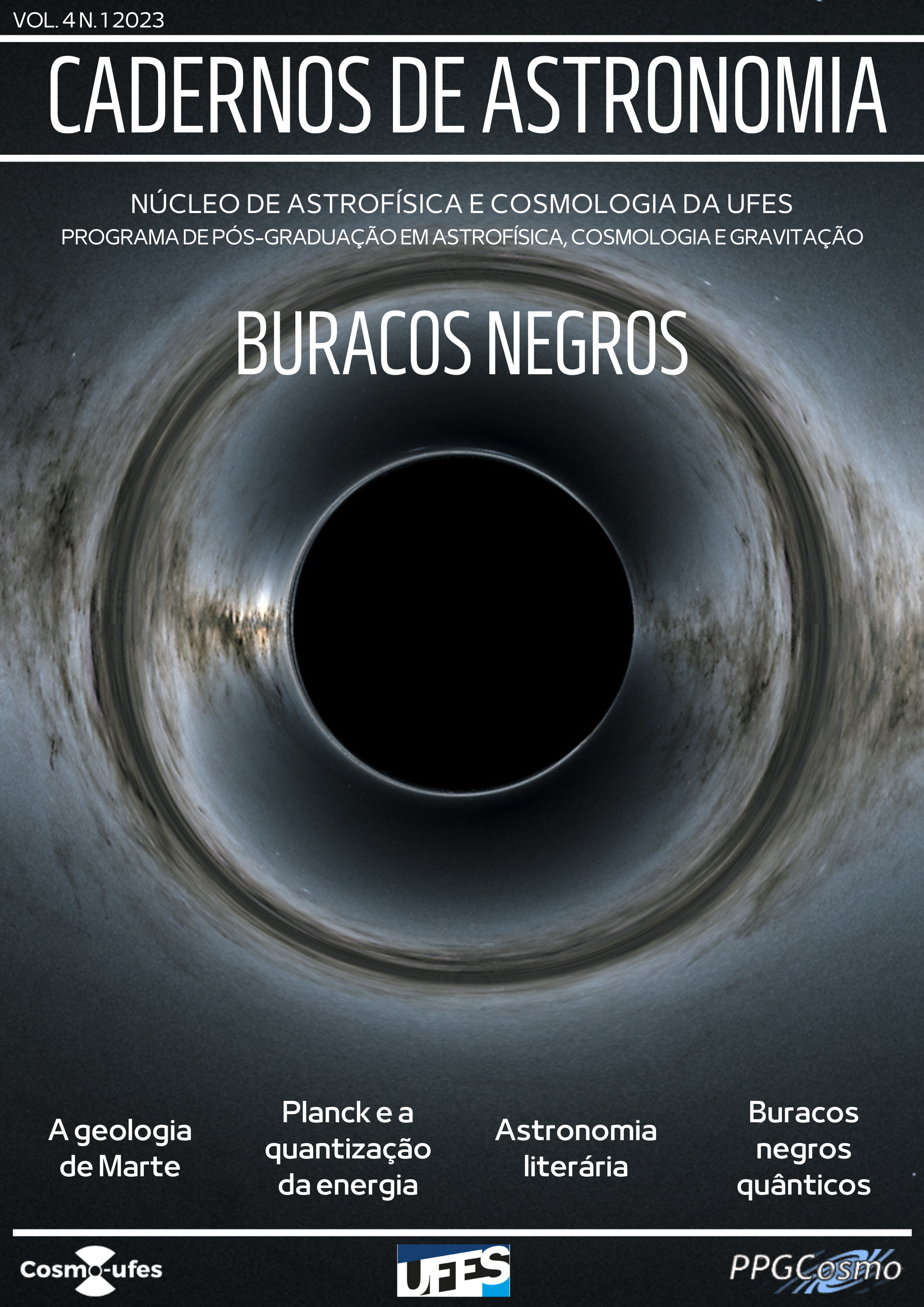Sobre Buracos Negros
DOI:
https://doi.org/10.47456/Cad.Astro.v4n1.39981Palabras clave:
Buracos Negros, Relatividade Geral, AstrofísicaResumen
Buracos negros são objetos astrofísicos com propriedades muito particulares e fascinante. A partir de hipóteses genéricas, como a validade da teoria da relatividade geral, é possível provar teoremas que garantem a existência e propriedades desses objetos. Porém, apenas a observação e os experimentos são capazes de testar e verificar afirmações sobre fenômenos naturais. Seguindo este raciocínio, iremos desenvolver os conceitos básicos do que é um buraco negro, explicitar algumas de suas propriedades peculiares e por fim pontuar as observações que comprovaram a existência desses objetos compactos.
Referencias
J. Michell, On the means of discovering the distance, magnitude, &c. of the fixed stars, in consequence of the diminution of the velocity of their light, in case such a diminution should be found to take place in any of them, and such other data should be procured from observations, as would be farther necessary for that purpose. by the rev. john michell, b. d. f. r. s. in a letter to henry cavendish, esq. f. r. s. and a. s., Philosophical Transactions of the Royal Society 74, 35 (1784).
P.-S. Laplace, Beweis des satzes, dass die anziehende kraft bey einem weltkörper so gross seyn könne, dass das licht davon nicht ausströmen kann., Allgemeine Geographische Ephemeriden 4, 1 (1799). Disponível em https://ui.adsabs.harvard.edu/abs/1799AllGE...4....1L/abstract, acesso em fev. 2023.
R. M. Wald, General Relativity (The University of Chicago Press, 1984).
K. Schwarzschild, On the gravitational field of a mass point according to Einstein’s theory, Sitzungsber. Preuss. Akad. Wiss. Berlin (Math. Phys. ) 1916, 189 (1916). ArXiv: physics/9905030.
H. Reissner, Über die Eigengravitation des elektrischen Feldes nach der Einsteinschen Theorie, Annalen der Physik 355(9), 106 (1916).
G. Nordström, On the Energy of the Gravitation field in Einstein’s Theory, Koninklijke Nederlandse Akademie van Wetenschappen Proceedings Series B Physical Sciences 20, 1238 (1918).
R. P. Kerr, Gravitational Field of a Spinning Mass as an Example of Algebraically Special Metrics, Phys. Rev. Lett. 11(5), 237 (1963).
E. T. Newman et al., Metric of a Rotating, Charged Mass, Journal of Mathematical Physics 6(6), 918 (1965).
S. W. Hawking, Particle Creation by Black Holes, Commun. Math. Phys. 43, 199 (1975),
[Erratum: Commun.Math.Phys. 46, 206 (1976)].
J. D. Bekenstein, Black holes and the second law, Lett. Nuovo Cim. 4, 737 (1972).
J. D. Bekenstein, Generalized second law of thermodynamics in black-hole physics, Phys. Rev. D 9(12), 3292 (1974).
B. P. Abbott et al. e LIGO Scientific Collaboration and Virgo Collaboration, Observation of gravitational waves from a binary black hole merger, Phys. Rev. Lett. 116, 061102 (2016).
A. Kazunori et al. e The Event Horizon Telescope Collaboration, First M87 event horizon telescope results. IV. Imaging the central supermassive black hole, The Astrophysical Journal Letters 875(1), L4 (2019).
A. Kazunori et al. e The Event Horizon Telescope Collaboration, First Aagittarius A* event horizon telescope results. I. The shadow of the supermassive black hole in the center of the Milky Way, The Astrophysical Journal Letters 930(2), L12 (2022).
Descargas
Publicado
Número
Sección
Licencia
Derechos de autor 2023 Felipe Tovar Falciano

Esta obra está bajo una licencia internacional Creative Commons Atribución 4.0.






